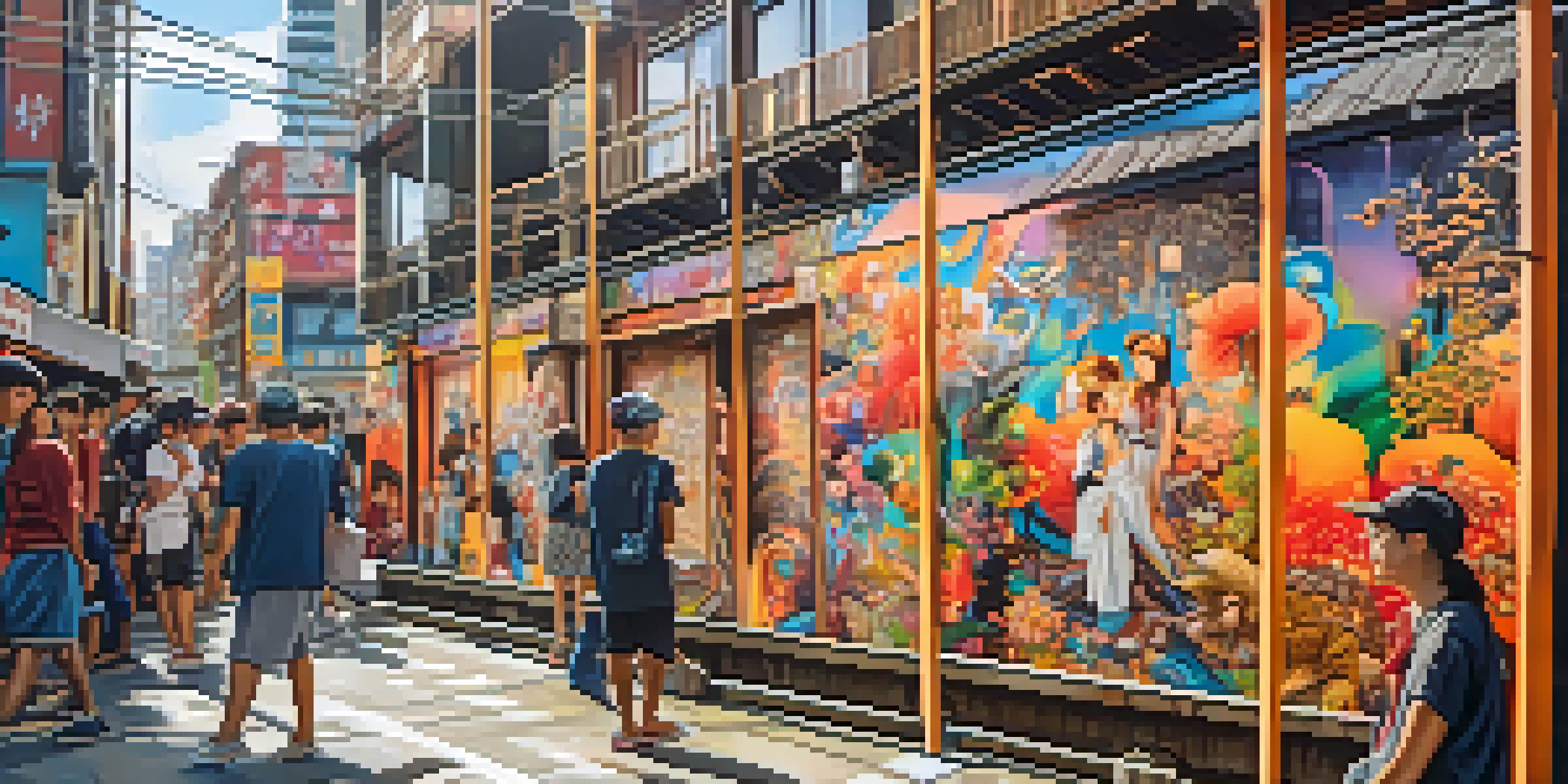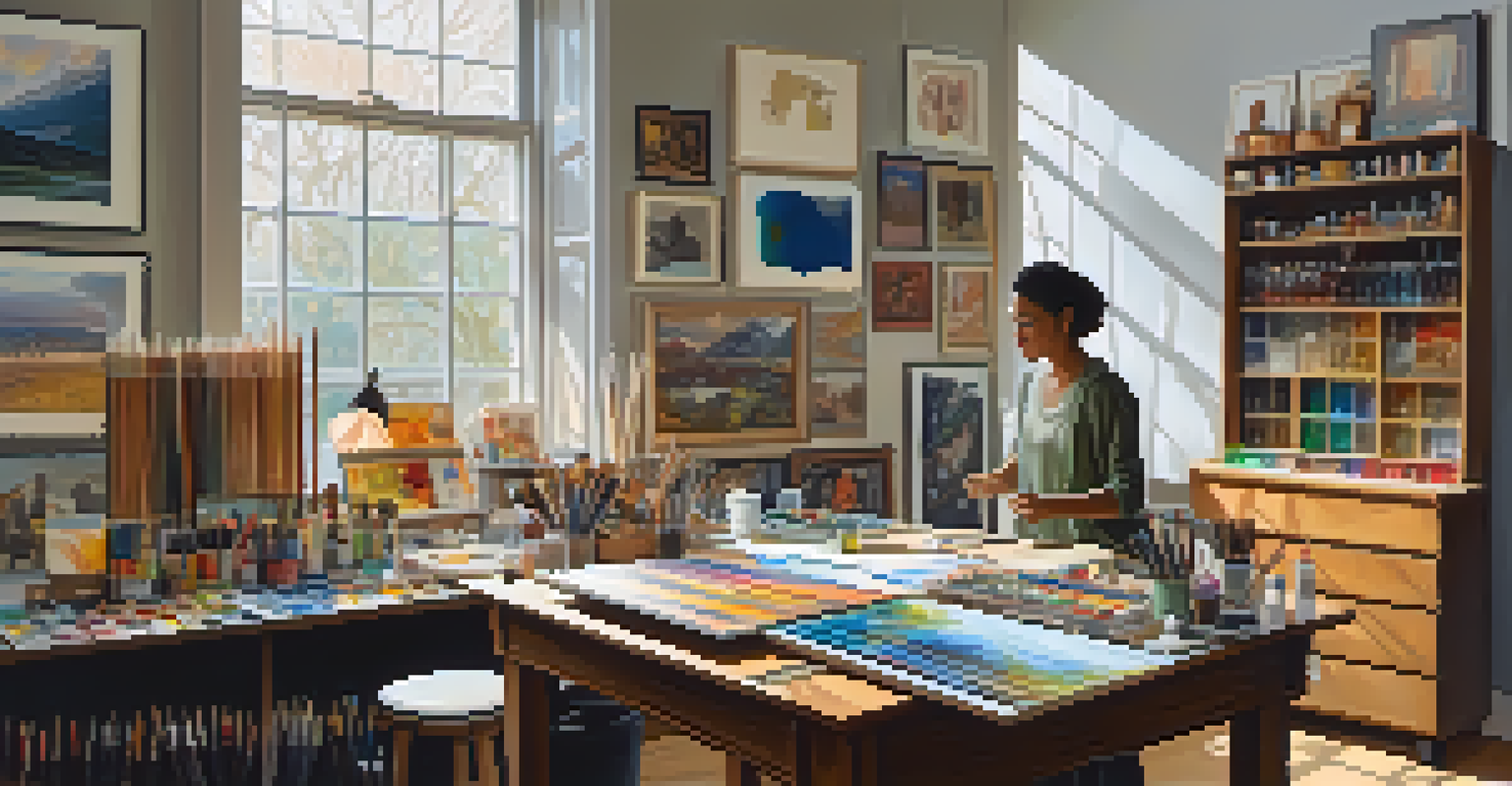The Influence of Globalization on Contemporary Art Movements

Understanding Globalization in the Art World
Globalization refers to the interconnectedness of cultures, economies, and people across the globe. In the art world, this phenomenon allows artists to draw inspiration from diverse cultural backgrounds, leading to a rich tapestry of ideas and expressions. For instance, an artist from Japan might incorporate Western techniques into traditional forms, creating a unique fusion that resonates with a global audience.
Art is a reflection of the times. It is a way to express the collective fears and hopes of a society.
This blend of influences encourages artists to step outside their cultural boundaries, exploring themes and materials that might have been previously inaccessible. As a result, contemporary art becomes a dialogue rather than a monologue, inviting viewers to engage with a range of perspectives. This transformation is especially evident in galleries and exhibitions that showcase international artists side by side.
Furthermore, the rise of digital platforms has amplified this effect, enabling artists to share their work with a global audience instantly. Social media and online galleries have democratized art distribution, allowing emerging artists from diverse backgrounds to gain recognition and connect with like-minded individuals worldwide.
Cultural Exchange and Artistic Innovation
One of the most exciting aspects of globalization is the cultural exchange it fosters among artists. This exchange often leads to innovative artistic practices that challenge traditional norms and push boundaries. For example, the incorporation of street art into fine art has drawn from urban cultures around the world, creating a new genre that speaks to contemporary societal issues.

Artists increasingly collaborate across borders, blending techniques and materials to create works that reflect a global narrative. Notable collaborations, such as those between African and European artists, often result in pieces that challenge preconceived notions of identity and cultural ownership. This collaboration not only enriches the artists' own practices but also broadens the audience's understanding of art itself.
Globalization Enhances Artistic Diversity
Globalization allows artists from different cultures to blend influences, creating innovative and diverse expressions in contemporary art.
Moreover, these innovative practices often address pressing global issues, such as climate change, migration, and social justice. By collaborating and sharing their unique viewpoints, artists can create impactful pieces that resonate on multiple levels, prompting viewers to reflect on their own positions within these global conversations.
The Role of Technology in Art Globalization
Technology plays a crucial role in the globalization of contemporary art, facilitating new forms of expression and engagement. Digital tools and platforms allow artists to create and share their work more widely than ever before. For instance, virtual reality installations can transport viewers to different environments, creating immersive experiences that transcend geographical limitations.
The role of an artist is to make the world a better place by creating art that speaks to the issues of our time.
Furthermore, online art marketplaces and social media platforms have given rise to a new generation of art collectors and enthusiasts. This accessibility enables artists from diverse backgrounds to reach audiences that may have been out of reach in the past. As a result, the art world is becoming more inclusive, allowing for a wider range of voices to be heard.
However, the reliance on technology also raises questions about authenticity and the commodification of art. As artists navigate this digital landscape, they must balance the benefits of global exposure with the potential loss of their unique cultural identities. This ongoing dialogue highlights the complexities of creating art in a globalized world.
Globalization's Impact on Art Markets
Globalization has significantly altered the landscape of art markets, creating both opportunities and challenges for artists and collectors. The rise of international art fairs and auctions has provided artists with unprecedented access to global collectors, fostering a dynamic marketplace. This shift enables emerging artists to gain visibility alongside established names, creating a more diverse art economy.
However, this increased competition also poses challenges, as artists must navigate the complexities of branding and marketing their work in a saturated market. The pressure to appeal to a global audience can sometimes dilute an artist's unique voice or cultural identity. It's a balancing act that many contemporary artists are still figuring out as they carve out their niche in this new landscape.
Technology Transforms Art Accessibility
Digital platforms and tools have expanded the reach of artists, enabling them to connect with global audiences and democratizing art distribution.
Moreover, the impact of globalization on art markets can lead to the commodification of culture, where unique artistic expressions risk being reduced to mere products. This raises vital questions about the value of art and the responsibility of collectors and institutions in supporting authentic voices in the global marketplace.
The Influence of Global Art Institutions
Global art institutions play a significant role in shaping contemporary art movements through their programming and exhibitions. Institutions like the Venice Biennale and the Tate Modern have become platforms for international artists to showcase their work, often highlighting themes of globalization and cultural exchange. These exhibitions not only bring visibility to underrepresented artists but also encourage dialogue about cultural narratives.
Moreover, funding and support from these institutions can greatly impact an artist's career trajectory. Grants and residencies provide artists with the resources they need to create and share their work on a global stage. This support often leads to cross-cultural collaborations, further enriching the contemporary art landscape.
However, the influence of global art institutions can also be a double-edged sword. As they curate exhibitions, the selection often reflects the prevailing tastes of the art world, which can inadvertently marginalize certain voices. This dynamic raises important discussions about who gets to define contemporary art and which narratives are prioritized in the global conversation.
Art as a Reflection of Global Issues
Contemporary art often serves as a lens through which we can examine pressing global issues. Artists today are increasingly using their work to comment on themes such as migration, inequality, and climate change. This reflective quality not only engages viewers but also fosters a deeper understanding of the complexities of our interconnected world.
For instance, artists like Ai Weiwei use their platforms to address human rights violations and social injustices, sparking conversations that transcend borders. By bringing attention to these issues through their art, they encourage audiences to reflect on their roles in a global society. This engagement is vital, as it transforms art into a powerful tool for activism and change.
Art Reflects Global Social Issues
Contemporary art serves as a powerful medium for addressing pressing global issues, encouraging viewers to engage with themes of migration, inequality, and climate change.
In this way, art becomes a bridge connecting diverse communities and fostering empathy. As viewers encounter these global narratives through art, they are invited to question their own perspectives and consider the shared experiences that unite us all, regardless of cultural background.
The Future of Globalization in Art
As we look to the future, the influence of globalization on contemporary art is likely to continue evolving. Artists will increasingly navigate the complexities of identity, culture, and technology, creating works that reflect the diverse narratives of our interconnected world. This evolution will be shaped by ongoing dialogues about authenticity, representation, and the role of technology in art.
Moreover, as global challenges persist, artists will increasingly respond to these issues through their work. The themes of social justice, environmental sustainability, and cultural identity will likely remain at the forefront of contemporary art movements. This proactive engagement will ensure that art continues to be a relevant and powerful medium for addressing the complexities of our time.

Ultimately, the future of globalization in art holds immense potential for creativity and cultural exchange. As artists from diverse backgrounds collaborate and share their unique perspectives, contemporary art will continue to evolve, reflecting the vibrant tapestry of our global society.